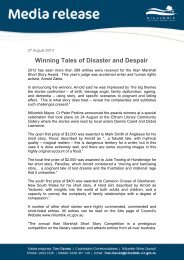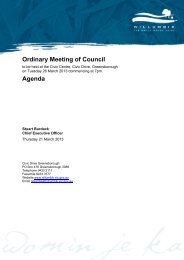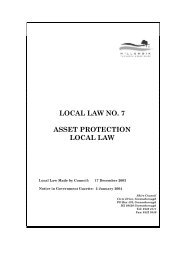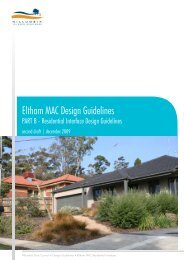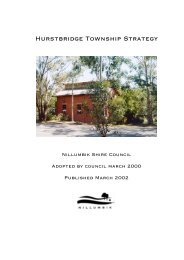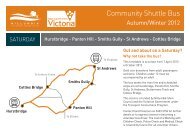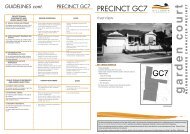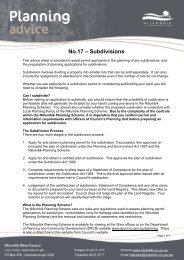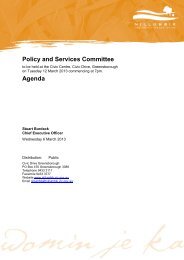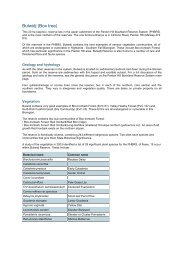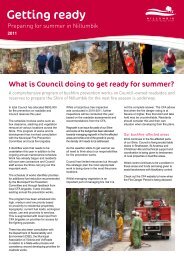Municipal Fire Management Plan 2013â2016 - Nillumbik Shire ...
Municipal Fire Management Plan 2013â2016 - Nillumbik Shire ...
Municipal Fire Management Plan 2013â2016 - Nillumbik Shire ...
Create successful ePaper yourself
Turn your PDF publications into a flip-book with our unique Google optimized e-Paper software.
Working GroupsThe MEMPC or MFMPC may from time to time appoint working groups to assist with fire managementplanning. The MEMPC has endorsed a working group made up of the 13 local brigades‘representatives and others as required. The purpose of this group is to ensure that the MFMPC isinformed by local knowledge. The working group will report to the MEMPC through the CFAdelegates on the MFMPC. (For more information on the Working Group, see Attachment 2 of thisdocument: Terms of Reference, Brigade Working Group).2 ENGAGEMENT AND COMMUNICATIONSA requirement of the <strong>Nillumbik</strong> <strong>Shire</strong> Council <strong>Municipal</strong> <strong>Fire</strong> <strong>Management</strong> <strong>Plan</strong> is the development ofa Stakeholder Engagement and Communications <strong>Plan</strong> (see Attachment 3 of this document) to guidehow fire management objectives and outcomes are communicated both to stakeholders and to thebroader community.Community Engagement is guided by the International Association for Public Participation (IAP2)community engagement model, which is a framework for planning effective communication andengagement on any issue or plan.Using the IAP2 framework model, it‘s important that stakeholders understand and appreciate thegoals and objectives of fire management planning. By clearly communicating these objectives,stakeholders will ‗own‘ the <strong>Plan</strong> and make positive contributions both to the <strong>Plan</strong> and the Committee.A stakeholder consultation plan and process has been developed for the successful development andimplementation of this <strong>Plan</strong>. Stakeholders involved in fire management planning in the <strong>Nillumbik</strong><strong>Shire</strong> Council have been listed in this <strong>Plan</strong> (see Attachment 2: Stakeholder Analysis) and their level ofparticipation and involvement noted.3 ENVIRONMENTAL SCAN<strong>Nillumbik</strong> <strong>Municipal</strong> ProfileLocated 25 kilometres northeast of Melbourne, the municipality of <strong>Nillumbik</strong> covers 431.94 squarekilometres, and has an estimated population of 64,219. The most southerly point is bound by theYarra River and is characterised by predominately urbanised residential allotments, including Eltham,Hurstbridge and Diamond Creek. It extends 29 kilometres north to Kinglake National Park andstretches approximately 20 kilometres from the Plenty River and Yan Yean Road in the west toChristmas Hills, and the Yarra escarpment in the east, all characterised by an urban-rural interface.The municipality includes a wide variety of topographies, ranging from gentle undulating slopes atKangaroo Ground to very steep and heavily treed areas around Plenty Gorge, North Warrandyte andthe Kinglake National Park. There are over 828 hectares of nature and recreation reserves within themunicipality. Ground cover in grassland areas is generally medium to heavy depending on the extentof grazing.<strong>Nillumbik</strong> is covered by vegetation, environmental and landscape-based overlays, which seek toprotect native vegetation. The <strong>Nillumbik</strong> Green Wedge covers 91 per cent of the municipality, yetwhilst the municipality of <strong>Nillumbik</strong> is referred to as the ‗Green Wedge <strong>Shire</strong>‘; in Land Use <strong>Plan</strong>ningterms, green wedge land is defined as being outside the urban growth boundary. The <strong>Nillumbik</strong>Green Wedge supports a diverse range of species and their habitats. It is home to 1,000 indigenousflora species, 64 of which are listed significant species.The <strong>Nillumbik</strong> Green Wedge is in the catchment of the Yarra River and is bordered by the PlentyRiver in the west and the Yarra River to the south and south-east. Apart from natural waterways, the<strong>Nillumbik</strong> Green Wedge is the location for key parts of Melbourne‘s infrastructure for potable waterstorage. As a result, the development pattern across the municipality is one that consists of dwellings<strong>Nillumbik</strong> <strong>Municipal</strong> <strong>Fire</strong> <strong>Management</strong> <strong>Plan</strong> 2013-2016 Page 8



